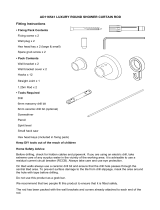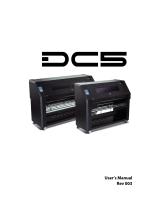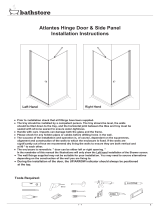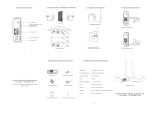Page is loading ...

11/15 EINS 516637
PLEASE READ THESE INSTRUCTIONS BEFORE COMMENCING SITE SURVEY
OR INSTALLING THIS APPLIANCE.
REMEMBER: when replacing a part on this appliance, use only spare parts that
you can be assured conform to the safety and performance specification that we
require. Do not use reconditioned or copy parts that have not been clearly
authorised by AGA.
For use in GB and IE
Installation
Guide
AGA DUAL CONTROL
Model No’s: DC3 & DC5
(Includes External Vent &
Room Vent Option)

SECTION PAGE
HEALTH & SAFETY 3
INSTALLATION REQUIREMENTS 3
DELIVERY REQUIREMENTS 3
APPLIANCE DIMENSIONS - AGA DC3 4
APPLIANCE DIMENSION - AGA DC5 5
CLEARANCES 6
TOP PLATE ADJUSTMENT - AGA DC3 7
POWER SUPPLY - AGA DC3 8
POWER SUPPLY - HOTCUPBOARD (AGA DC5) 8
MAINS CABLE ROUTING - AGA DC3 9
MAINS CABLE ROUTING - AGA DC5 10
(HOTCUPBOARD OPTION)
EXTERNAL VENT MODELS - VENT PIPE CONNECTION 11
ROOM VENTED MODELS 12
OVEN VENTING SYSTEMS 13
HOTCUPBOARD INSTALLATION 14 - 20
HANDRAIL CONNECTION - AGA DC3 19
HANDRAIL CONNECTION - AGA DC5 19
WIRING DIAGRAM - AGA DC3 21
WIRING DIAGRAM - HOTCUPBOARD 22
AGA DUAL CONTROL CHECKLIST 23
2
CONTENTS

HEALTH AND SAFETY
Consumer Protection
As responsible manufacturers we take care to make sure that our products are designed and
constructed to meet the required safety standards when properly installed and used.
PLEASE READ THE ACCOMPANYING WARRANTY.
Any alteration that is not approved by AGA could invalidate the approval of the appliance,
operation of the warranty and could also affect your statutory rights.
In the interests of safety and effective use, please read the following before using your new AGA
appliance.
Important
This appliance may contain some of the materials that are indicated below. It is the
Users/Installers responsibility to ensure that the necessary personal protective clothing is worn
when handling, where applicable, the pertinent parts that contain any of the listed materials that
could be interpreted as being injurious to health and safety, see below for information.
Fire Cement - when handling use disposable gloves.
Glues and Sealants - exercise caution - if these are still in liquid form use face mask and
disposable gloves.
Glass Yarn, Mineral Wool, Insulation Pads - may be harmful if inhaled, may be irritating to
skin, eyes, nose and throat. When handling avoid inhaling or contact with skin or eyes. Use
disposable gloves, face masks and eye protection. After handling wash hands and other
exposed parts. When disposing of the product, reduce dust with water spray, ensure that parts
are securely wrapped.
INSTALLATION REQUIREMENTS
THIS APPLIANCE MUST ONLY BE INSTALLED BY COMPETENT ENGINEERS WHO HAVE
BEEN SPECIFICALLY FACTORY TRAINED ON THE PRODUCT AND WHO HAVE THE
APPROPRIATE EQUIPMENT.
With specific exceptions, the installing of any type of AGA cooker is subject to the respective
directions contained in the current issue of the Building Regulations. In addition, planning
permission may need to be obtained, which should be applied for separately.
The installation of the appliance must be in accordance with the relevant requirements of the IEE
Wiring Regulations and Building Regulations. It should be in accordance also with any
requirements of the local authority.
In your own interest, and that of safety to comply with the law. all appliances should be installed
by an authorised AGA engineer or distributor, in accordance with the relevant regulations.
3
DELIVERY REQUIREMENTS
The AGA DC3 arrives on 1 pallet
The AGA DC5 (Hotcupboard) arrives on 2 pallets.
There must be access to the kitchen to manipulate a foot print of 1005mm x 740mm. A wooden
template (skate with castor wheels) of dimensions 1005mm x 740mm could be used to check if
the AGA Dual Control fully built appliance is able to fit through the property grounds and doors
into its installation position in the kitchen. It must also be considered that the height of the
appliance is 960mm off pallet and 1100mm on the pallet, so high level obstacles/restrictions must
not be overlooked.
If this skate/template can be manipulated through the property grounds and doors
into position, then the AGA can be installed as intended with no re-work.

4
APPLIANCE DIMENSIONS - AGA DC3
Fig. 1 DESN 516358 B
Cooker Dimensions
When surveying for a cooker installation the actual clearance required for the ‘body’ of the
appliance should be increased by 10mm beyond the figures quoted above. This allows safe
margin to take into account the natural dimensional variations found in major castings. In
particular the width across the appliance recess could be critical.
APPLIANCE WEIGHT (Excludes Packaging)
Model: AGA Dual Control (DC3) - 444kg
A B C D E F G H J K L M N P Q R
mm 987 951 913 680 1388 760 1145 698 116 10 559 813 30 634 422 849

5
APPLIANCE DIMENSIONS - AGA DC5
Fig. 2 DESN 516659 A
Cooker Dimensions
When surveying for a cooker installation the actual clearance required for the ‘body’ of the
appliance should be increased by 10mm beyond the figures quoted above. This allows safe
margin to take into account the natural dimensional variations found in major castings. In
particular the width across the appliance recess could be critical.
APPLIANCE WEIGHT (Excludes Packaging)
Model: AGA Dual Control (DC3) - 444kg
Hotcupboard - 110kg
A B C D E F G H J K L M N P Q R
mm 1478 951 913 680 1388 760 1145 698 116 10 559 849 30 634 422 813

CLEARANCES
The complete cooker is floor-mounted and the space in which the appliance is to be fitted must
have the following minimum dimensions:-
A minimum clearance of 60mm is required above the raised insulating cover handle.
Side Clearances: A 3mm gap is required each side between the cooker top plate and adjoining
work surfaces that may be fitted, this is to allow for the safe removal of the top plate should this
be required at a later date.
Where cookers are fitted against side walls a 116mm clearance is required on the right and
left hand side for oven doors access.
If the AGA is to be installed in a brick recess, then the minimum clearance should be
increased by at least 10mm, to allow for the walls not being square.
In addition, a minimum clearance of 1000mm must be available at the front of the cooker
to enable the cooker to be serviced.
Cooker Base or Hearth
It is essential that the base or hearth on which the cooker stands should be level and be capable
of supporting the total weight of the appliance. The base of the built-in AGA plinth must be level
and sit above finished floor height for service access.
The front plinth cover is removable and must not be obstructed by flooring or tiles. If necessary
the cooker must be raised by the thickness of the tiles to ensure the plinth can be removed.
Shims are provided to eliminate rocking.
Tiling
When the cooker is to stand in a recess or against a wall which is to be tiled, in no circumstances
should the tiles overlap the cooker top plate, access to remove the top plate must be allowed for
servicing at a later date.
A gap of at least 10mm must be observed between the rear of the top plate, and the wall behind
the appliance.
6
Since this appliance can be used continuously, please take note of these IMPORTANT
instructions:
Combustible Walls
Houses constructed of combustible materials (such as all-timber or stud wall partitions and
batoned plasterboarded walls) require special wall heat protection features.
Non-combustible walls behind a cooker must be of at least 25mm thick insulation board
(Monolux or equivalent), up to hotplate level.
In addition, oven vent piping must be insulated with the high temperature film glass sleeving,
supplied, and a 25mm gap.
SPECIAL NOTE: Ensure electric cabling or plastic services do not pass within or on the
outside of the wall, behind or directly above the cooker.
This type of material can age prematurely when exposed to continuous higher ambient
temperature.

Top Plate Adjustment - AGA DC3 (See Fig. 3)
In general, adjustment of the top plate is to be avoided. However minimum use of the top plate
adjusters can be used to improve the alignment of the top plate.
7
Fig. 3 DESN 516751

8
POWER SUPPLY - AGA DC3
WARNING: THIS APPLIANCE MUST BE EARTHED.
THIS APPLIANCE IS DESIGNED FOR THE VOLTAGE STATED ON THE RATING PLATE,
WHICH IS SITUATED BEHIND THE PLINTH COVER.
A 1PH 32 amp 230V or 3PH 400V minimum 16A per phase ~ 50 Hz fused electrical supply is
required adjacent to the appliance. External wiring to the unit must be installed using the mains
cable provided, in accordance with the current wiring regulations and any local regulations which
apply. If cable is shortened, new ferrules must be fitted to the stripped conductors.
The method of connection to the mains electricity supply must facilitate complete electrical
isolation of the appliance, by a multi-pole switch, having a contact separation of at least 3mm on
all poles.
The isolator should not be positioned immediately above the cooker, but must be fitted within 2
metres of the appliance.
The isolator maybe separate from the connection point.
The mains connection point must be accessible within the areas shown in Fig 4A, Page 9 for
cable routing options.
For 2 or 3 phase installations an optional adaptor kit must be obtained (Part No. AE4M280352).
POWER SUPPLY - HOTCUPBOARD (AGA DC5)
THE HOTCUPBOARD ATTACHMENT REQUIRES AN INDEPEDENT SINGLE PHASE
POWER SUPPLY.
WARNING: THIS APPLIANCE MUST BE EARTHED.
THIS APPLIANCE IS DESIGNED FOR THE VOLTAGE STATED ON THE RATING PLATE,
WHICH IS SITUATED ON A SLIDE-OUT TRAY IN THE HOTCUPBOARD BASE PLATE
ABOVE THE PLINTH.
A 230v ~ 50 Hz, 3 amp fused electrical supply is required adjacent to the appliance. (with the
exception of the AGA TC5 and DC5 Hotcupboard with Induction Hob model, please refer to the
AGA Induction Hob model for instructions for the power supply requirements). External wiring to
the unit must be installed using a 3 core silicon - SIHF insulation cable and in accordance with
the current wiring regulations and any local regulations which apply.
The method of connection to the mains electricity supply must facilitate complete electrical
isolation of the appliance, preferably by a fused double pole switch, having a contact separation
of at least 3mm in both poles.
The isolator should not be positioned immediately above the appliance, but must be fitted within
2 metres of the appliance.

MAINS CABLE ROUTING - AGA DC3
Fig. 4 DESN 516643
MAINS CABLE FED FROM
CONTROL TRAY LEFT OR
RIGHT EXIT THROUGH
DUCTING DEPENDENT UPON
POSITION OF SUPPLY SOCKET
9
Fig. 4A DESN 516105
THE MAINS SUPPLY CONNECT POINT MUST BE WITHIN THE ZONES SHOWN

MAINS CABLE ROUTING - AGA DC5 (HOTCUPBOARD OPTION)
Fig. 5 DESN 516644
MAINS CABLE FED FROM CONTROL
TRAY LEFT OR RIGHT EXIT
THROUGH DUCTING DEPENDENT
UPON POSITION OF SUPPLY
SOCKET
10
Fig. 5A DESN 516447
THE MAINS SUPPLY CONNECT POINT MUST BE WITHIN THE ZONES SHOWN
HOTCUPBOARD
POWER SUPPLY

EXTERNAL VENT MODELS - VENT PIPE CONNECTION
Fig. 6 DESN 516653
The appliance is shown with the oven venting from the RH side.
Access to vent pipe fitting, through rectangular cut-out
It can also be vented from the rear and exiting through hole in back panel.
Reseal pipe connection with aluminium tape.
When installing a AGA DC5 which is venting to the left hand side, care must always be taken
to ensure the vent pipe is fully lagged (using insulation provided). Where the vent pipe passes
behind the hotcupboard, ensure that the mains cable is kept away from the hot surface of the
vent pipe.
Rear or right hand venting is preferable on AGA DC5 installations.
NOTE: Vent pipe outlet under shroud to be left open. DO NOT CAP OFF
.
11
NOTE: THE VENT OPENING UNDER THE SHROUD SHOULD BE
LEFT OPEN NOT CAPPED
.
EXTERNAL MODEL CAN BE VENTED FROM
LEFT HAND, RIGHT HAND OR
REAR OF APPLIANCE

ROOM VENTED MODELS
Fig. 7 DESN 516752
VENT UNDER SHROUD TO
BE LEFT OPEN
NOTE: ON ROOM VENT MODEL COPPER
END CAP TO BE PUSHED IN PLACE ON
INSTALLATION
12
Room Vented Models
It is recommended that this model is fitted in conjunction with a cooker hood. The AGA oven
venting outlet is located on the top of the AGA between the two hotplates., and is designed for
venting the moisture from the ovens. The cooker hood should be positioned not less than the
minimum height as recommended by the manufacturer, from the top of the AGA.
These are 650mm for AGA Rext 720 650mm for AGA 1000 SE

OVEN VENTING SYSTEMS
See Fig. 8
The appliance oven venting pipe can be achieved up to a maximum length of 6 metres, through
an outside wall. Great care must be taken in all-timber houses.
If the oven vent pipe passes through combustible material, there must be an air gap of at least
25mm around the pipe and preferably wrapped with insulation material.
The max supply to the motor, as calculated should be limited to 24V (DC), for ideal
operating conditions.
Calculating the voltage for the particular pipework is as follows:-
1. Keep the pipe run as simple as possible - avoid bends.
2. “Vertical risers” are not permitted.
3. Pipe run should be horizontal - slight downwards slope towards the fan.
Minimum 12 volts for first metre of vent pipe run inclusive of 1 bend
Each extra metre add 1 volt.
Each extra bend add 2 volts
Maximum allowed 24 volts.
Minimum setting is 15 volts.
NOTE: IN THE OVEN VENTING, PROVISION MUST BE MADE FOR EASY ‘RODDING’ OF
THE PIPEWORK TO FACILITATE CLEANING.
13
Fig. 8 DESN 516111

HOTCUPBOARD INSTALLATION
Fig. 9 DESN 516448
Fig. 10 DESN 516449
14
NOTE: The AGA DC5 hotcupboard should arrive with the top plate in a jacked up position. This
is to allow the complete appliance to be slid onto its plinth when alongside the AGA DC3 without
the top plates clashing. The hotcupboard top plate should then be wound down to its correct
height once the appliance is in its final position.
1. Detach hotcupboard from plinth by removing two screws and tongue bracket from plinth (See
Fig. 9), slide hotcupboard forwards and away from rear fixing bracket (See Fig. 10).

2. Position the plinth alongside the AGA Dual Control leaving no gap between the two plinths
(See Fig. 11).
Check with a spirit level that the plinth level is correct, and also check height differential
between the hotcupboard plinth and Dual Control plinth is correct (11mm). If necessary, use
shims in each corner to level the plinth.
Fig. 11 DESN 516276
HOTCUPBOARD
PLINTH BASE
11mm HEIGHT
DIFFERENTIAL
3. Attach hotcupboard plinth to the AGA Dual Control plinth using M6 screws and washers
provided (See Fig. 12).
Attach locking screw and jacking screw into plinth. Make sure at this stage that the jacking
screw does not protrude beyond outer face of plinth. Ensure locking screw is located into
AGA DC3 plinth but not fully tightened. A gap of approximately 3mm should be present
between the plinths apart from at the very front where the hotcupboard spacer plate should
be touching the AGA DC3 plinth.
Fig. 12 DESN 516550
15
+1
- 0

4. Run a straight edge along the front of the AGA Dual Control plinth, to ensure the front face
of both plinths sit squarely against the straight edge. (See Fig. 13)
When satisfied both plinths sit squarely, jacking screws can be tightened until they just make
contact with the AGA Dual Control plinth, and locking screws can now be tightened.
Fig. 13 DESN 516551
USE STRAIGHT EDGE ACROSS BOTH PLINTHS TO ENSURE PLINTHS
ARE ALIGNED SQUARELY
Fig. 14 DESN 516553
16
5. Front jointing bracket can now be hooked into place over the two pot magnets. This will latch
the two plinths together. (See Fig. 14)

Fig. 15 DESN 516552
7. The hotcupboard top plate is set 5mm higher than the AGA Dual Control top plate. This is to
prevent damage to the enamel during installation. Lower the top plate using the adjusters
(See Figs. 16 & 17).
Fig. 16 DESN 516554
17
6. Slide hotcupboard onto plinth until rear tongue bracket engages fully into rear of base slot,
(See Fig. 15). Ensure the appliance is aligned squarely with the plinth then proceed to
engage the front tongue bracket into the slot on the underside of the base plate. Once
satisfied that the front tongue bracket is engaged fully lock it into place by tightening the two
M6 screws fully. Ensure that the electrical cable does not come into contact with oven vent
pipe from the AGA DC3.

8. Using the stay rod nut adjusting tool, carefully lower the top plate adjusting nuts until the top
plate sits at the required height, making sure that the top sits level and matches the height
of the AGA DC3. (See Fig. 17).
Fig. 17 DESN 516555
18
9. Fit the handrail bracket over the fixing stud located on the top plate. Lock into position by
tightening the grub screw nearest the appliance. (See Fig. 18).
Fig. 18 DESN 516883

19
Fig. 19 DESN 516880
10. Next the handrail, endcaps and handrail require assembly.
Slide the handrail through the handrail brackets.
Fig. 20 DESN 516879
11. On 5 oven appliances, fit allthread stud into the insert located in the one end of the
handrail, then feed the handrail through the bracket (ensuring that the allthread stud is
protruding from the right hand side of the hotcupboard handrail) and screw the handrails
together. (See Fig. 20).
AGA DC5 HANDRAIL CONNECTION
AGA DC3 HANDRAIL CONNECTION

20
12. Once the handrail assembly is located squarely, lock the handrail in position by winding in
the grub screws on the underside of each handrail bracket.
13. Once the handrails are locked in position, fit the handrail endcaps. The endcaps should be
carefully pushed into place until they sit flush with the outside face of each bracket (a light
smear of lubricant such as, washing up liquid on the end cap ‘O’ rings may ease fitment.
14. Finally, fit the plinth facia to the magnets on the front of the plinth, making sure that on 5
oven appliances the right hand side of the module plinth facia sits against the left hand side
of the AGA Dual Control plinth facia leaving no gap between. Make sure that the plinth facias
are centrally located and do not overhang either appliance. (See Fig. 20)
Commission the AGA Dual Control, as stated in the relevant Installation Instructions and carry
out functional test on each of the features of the AGA Dual Control.
/





